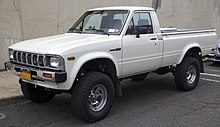
A | B | C | D | E | F | G | H | CH | I | J | K | L | M | N | O | P | Q | R | S | T | U | V | W | X | Y | Z | 0 | 1 | 2 | 3 | 4 | 5 | 6 | 7 | 8 | 9
| Toyota Hilux | |
|---|---|
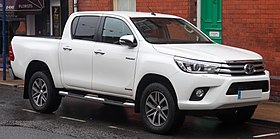 2016 Toyota Hilux Invincible (GUN125) | |
| Overview | |
| Manufacturer | Toyota |
| Also called | Toyota Pickup (United States, 1972–1995) |
| Production | March 1968 – present |
| Body and chassis | |
| Class |
|
| Chassis | Body-on-frame |
| Chronology | |
| Predecessor |
|
| Successor | Toyota Tacoma (North America, for N140/N150/N160/N170 model) |
The Toyota Hilux (Japanese: トヨタ・ハイラックス, Hepburn: Toyota Hairakkusu), stylized as HiLux and historically as Hi-Lux, is a series of pickup trucks produced and marketed by the Japanese automobile manufacturer Toyota. The majority of these vehicles are sold as pickup truck or cab chassis variants, although they could be configured in a variety of body styles.
The pickup truck was sold with the Hilux name in most markets, but in North America, the Hilux name was retired in 1976 in favor of Truck, Pickup Truck, or Compact Truck. In North America, the popular option package, the SR5 (Sport Runabout 5-Speed), was colloquially used as a model name for the truck, even though the option package was also used on other Toyota models, like the 1972 to 1979 Corolla. In 1984, the Trekker, the wagon version of the Hilux, was renamed the 4Runner in Venezuela, Australia and North America, and the Hilux Surf in Japan. In 1992, Toyota introduced a newer pickup model, the mid-size T100 in North America, necessitating distinct names for each vehicle other than Truck and Pickup Truck. Since 1995, the 4Runner is a standalone SUV, while in the same year Toyota introduced the Tacoma to replace the Hilux pickup in North America.
Since the seventh-generation model released in 2004, the Hilux shares the same ladder frame chassis platform called the IMV with the Fortuner SUV and the Innova minivan.
Cumulative global sales in 2017 reached 17.7 million units.[2] In 2019, Toyota revealed plans to introduce an electric-powered Hilux within six years.[3]
First generation (N10; 1968)
| First generation | |
|---|---|
 | |
| Overview | |
| Model code | N10 |
| Production | March 1968 – April 1972 |
| Assembly |
|
| Designer | Takayuki Otsuka[4] |
| Body and chassis | |
| Body style | 2-door truck |
| Layout | Front-engine, rear-wheel-drive |
| Powertrain | |
| Engine | |
| Transmission | 4-speed manual |
| Dimensions | |
| Length | 4,300–4,690 mm (169.3–184.6 in)[5] |
| Width | 1,610 mm (63.4 in)[5] |
| Height | 1,560–1,565 mm (61.4–61.6 in)[5] |
| Curb weight | 1,050–1,085 kg (2,314.9–2,392.0 lb)[5] |
The Hilux started production in March 1968[6] as the RN10 in short-wheelbase form with a 1.5 L inline-four engine, generating a maximum power output of 77 PS (57 kW; 76 hp) in Japanese market specification. The vehicle was conceived by Toyota, and was developed and manufactured by Hino Motors at its Hamura Plant.[7] In Japan, it was available at the Toyota Japan dealership retail chains called Toyota Store and Toyopet Store. The modification to the engine was enough for a claimed top speed of 130 km/h (81 mph).[8] The 1.5-litre engine was upgraded to a 1.6 L inline-four in February 1971.
In April 1969, a long-wheelbase version was added to the range. The short-wheelbase version also continued in production for many more years.[citation needed] The long-wheelbase version was not sold in the North American market until 1972, allowing the Datsun Truck to maintain a strong market presence. The Hilux was offered alongside the Toyota Crown, Toyota Corona, and Toyota Corona Mark II based pickup trucks in Japan until 1972, when the Crown, Corona, and Corona Mark II were repositioned as passenger sedans.
In spite of the name "Hilux", it was a luxury vehicle only when compared to the Stout. The Hilux was engineered and assembled by Hino Motors to replace the earlier vehicle that the Hilux was derived from, called the Briska[9] in the niche beneath the larger and older Stout – it replaced the Stout fully in some markets. For the North American market, the only body style was a regular cab short bed and all were rear-wheel drive. It used a typical truck setup of A-arms and coil springs in front and a live axle with leaf springs in back. A four-speed manual transmission was standard.
Starting in November 1971, final assembly of trucks for the US market was completed by Atlas Fabricators in Long Beach, California, later renamed Toyota Auto Body California.[10][11][12] Trucks were shipped from the factory in Japan as a chassis cab (the entire truck, less the truck bed). When the trucks arrived in the United States, a truck bed would be locally built and attached to the chassis before being sent to dealers. The arrangement was a form of tariff engineering, allowing Toyota to circumvent the chicken tax, a 25 percent tariff on imported light trucks.[13] By only importing a chassis cab, Toyota only had to pay a 4% tariff.[14]
Engines
Global markets:
North American markets:
- 1969: 1.9 L (1,897 cc) 3R I4, 85 hp (63 kW; 86 PS)
- 1970–1972: 1.9 L (1,858 cc) 8R SOHC I4, 97 hp (72 kW; 98 PS)
- 1972: 2.0 L (1,968 cc) 18R SOHC I4, 108 hp (81 kW; 109 PS)
Second generation (N20; 1972)
| Second generation (N20) | |
|---|---|
 | |
| Overview | |
| Model code | N20 |
| Production | May 1972 – July 1978 |
| Assembly |
|
| Designer | Masao Morimoto[4] |
| Body and chassis | |
| Body style | 2-door truck |
| Layout | Front-engine, rear-wheel-drive |
| Powertrain | |
| Engine | |
| Transmission |
|
| Dimensions | |
| Wheelbase |
|
| Length |
|
| Width | 1,580 mm (62.2 in) |
| Height | 1,570 mm (61.8 in) |
| Curb weight | 1,075–1,100 kg (2,370–2,425 lb) |
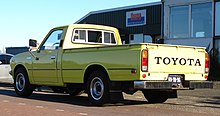
In May 1972,[6] the 1973 model year Hilux was introduced, designated the RN20. Nicknamed the "RokeHi" (ロケハイ), a portmanteau of "Rocket Hilux", it has a more comfortable interior along with exterior updates. A 2.25 m (7.4 ft) "long bed" was an option for the first time in North American markets, although such a version had been available worldwide since April 1969.[6] This received the "RN25" chassis code.[15] The 2.0 litre 18R engine was available in Japan as well, with a three-speed automatic transmission available as an option. The 2.0-litre automatic model managed a "gentle" 136.1 km/h (84.6 mph) top speed in a period road test conducted in South Africa, in spite of a claimed 89 kW (121 PS; 119 hp).[16]
The Hilux was radically redesigned in 1975 to be larger and with increased standard equipment. In North America, the new version also meant the introduction of the larger (2.2 L) 20R engine and the SR5 upscale trim package. A five-speed manual transmission became optional. In North America, the Hilux name was fully phased out in favour of "Truck" by that year, having been dropped from brochures and advertising campaigns, starting in 1973. Some North American motor-coach manufacturers began building Toyota motor-homes from the Hilux.
Engines
Global markets:
- 1972–1978: 1.6 L (1587 cc) 12R I4, 83 PS (61 kW) (SAE gross, Japan),[15] 67 PS (49 kW) (SAE net, general export)
- 1973–1978: 2.0 L (1968 cc) 18R I4, 105 PS (77 kW) (SAE gross, Japan)[6][17]
North American markets:
- 1973–1974: 2.0 L (1968 cc) 18R SOHC I4, 108 hp (81 kW; 109 PS)
- 1975–1978: 2.2 L (2189 cc) 20R SOHC I4, 96 hp (72 kW; 97 PS)
Third generation (N30, N40; 1978)
| Third generation | |
|---|---|
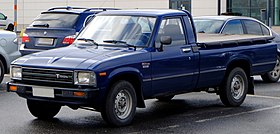 | |
| Overview | |
| Model code |
|
| Production | August 1978 – August 1983 |
| Assembly |
|
| Designer | Minoru Oya[4] |
| Body and chassis | |
| Body style |
|
| Layout | |
| Related | |
| Powertrain | |
| Engine | |
| Transmission | |
| Dimensions | |
| Wheelbase | |
| Curb weight |
|
The redesigned Hilux was introduced in August 1978,[6] with a 4WD variant introduced in January 1979.[6] The newer model was of similar dimensions to its predecessor, but both front and rear tracks were wider. Another change was the front suspension was changed from coil springs to a torsion bar design, still with a double wishbone layout.[20] The 4WD variant – not offered with any engines smaller than the two-litre "18R" – featured some common technology with the larger Toyota Land Cruiser.[9] Its front axle was a live, leaf-sprung design unlike the more car-like type used on rear-wheel drive Hiluxes. Production of the four-wheel drive models stopped in July 1983, but some 2WD variations continued production in parallel with the next generation models.[6] The L series diesel engine was offered on the 2WD variants from September 1979 and also on the 4WD variants beginning in March 1983.[6] In Japan, the Hilux was joined with the all new Toyota MasterAce, sharing load carrying duties which was sold at Toyota Store locations alongside the Hilux.
The Australian market originally received the 1.6-litre 12R engine in rear-wheel drive models, while 4WD models have the 2-litre 18R-C engine with 63 kW (86 PS).[21] These were all built on the longer wheelbase, with either pickup or cab-chassis bodywork. Top speed of the Australian Hilux 4WD was 130 km/h (81 mph).[22]
In North American markets, the Hilux (known as the Pickup) saw the use of four-wheel drive. It had a solid front axle and leaf suspension. The body saw a redesign that included single round headlights and a less complex body. This new 4WD setup featured a gear driven RF1A transfer case. This transfer case is unique in that its low-range reduction portion can be replicated, using what some refer to as a dual or triple transfer case. This results in a much lower overall gear ratio.[23] It was the first Hilux available with an automatic transmission in that market.
In 1981, a vehicle development agreement was established between Toyota, Winnebago Industries and two other aftermarket customisers. This was to allow Toyota to enter the SUV market in North America. The vehicles which resulted from this collaboration were the Trekker (Winnebago), Wolverine, and the Trailblazer (Griffith). All three used the Hilux 4×4 RV cab and chassis, and an all-fiberglass rear section (the Trailblazer had a steel bed with a fiberglass top). Research and development work on the Trekker led to the development of the 4Runner/Hilux Surf, which was introduced in 1984.
Toward the end of the SR5's production run (19831⁄2 model year), Toyota introduced the luxury Mojave trim for the US market as a limited-production (3,500 units) model with options not available on any other Toyota pickup.[24] With a list price of US$8,308 (equivalent to $25,415 in 2023),[24] it had bucket seats, two-speaker multiplex radio, chrome front and rear bumpers, and deleted Toyota logos on either the grille or the tailgate.[24] Cruise control, power steering, and air conditioning were optional.[24] It was powered by the SR5's standard 2.4 L (150 cu in) inline-four engine.[24]
In Thailand, this model was sold as the Toyota Hilux Super Star.
Engines
- 1978–1983: 1.6 L (1,587 cc) 12R SOHC I4, 80 PS (59 kW) at 5,200 rpm and 12.5 kg⋅m (123 N⋅m) of torque at 3,000 rpm (RN30/40, Japan)[19] 51 kW (69 PS; 68 hp) at 5,200 rpm[20]
- 1981–1983: 1.8 L preflow, 4-speed manual (Australia),[citation needed]
- 1978–1983: 2.0 L (1,968 cc) 18R SOHC I4, 89 PS (65 kW) at 5,000 rpm and 14.8 kg⋅m (145 N⋅m) of torque at 3,600 rpm (1983 European specifications)[25]
- 1978–1980: 2.2 L (2,189 cc) 20R SOHC I4, 67 kW (91 PS; 90 hp) at 4,800 rpm and 165 N⋅m (122 lb⋅ft) of torque at 2,400 rpm
- 1981–1983: 2.4 L (2,366 cc) 22R SOHC I4, 98 PS; 97 hp (72 kW) at 4,800 rpm and 175 N⋅m (129 lb⋅ft) of torque at 2,800 rpm
- 1979–1983: 2.2 L diesel I4, 46 kW (63 PS; 62 hp) at 4,200 rpm and 126 N⋅m (93 lb⋅ft) of torque (SR5 long bed only in the US), LN30/40
Fourth generation (N50, N60, N70; 1983)
| Fourth generation | |
|---|---|
 | |
| Overview | |
| Model code |
|
| Also called |
|
| Production |
|
| Model years | 1984–1988 |
| Assembly |
|
| Designer | Hiroshi Osawa[4] |
| Body and chassis | |
| Body style |
|
| Layout | |
| Related | |
| Powertrain | |
| Engine | |
| Transmission |
|
| Dimensions | |
| Wheelbase |
|
| Length |
|
| Width |
|
| Height |
|
| Curb weight | 1,270 kg (2,800 lb) |
The August 1983 redesign (sold as model year 1984 vehicles in North America) introduced the Xtracab extended cab option, with six inches of space behind the seat for in-cab storage. These models carried over the carbureted 22R engine while model year 1984 also saw the introduction of the fuel injected 22R-E engine. Two diesel engines were also offered, the 2L and the turbocharged 2L-T. The engines were discontinued in the U.S. after the 1986 model year, this was due to higher performance expectations from customers and the wide availability of inexpensive petrol. The next year saw the introduction of a turbocharged option, the 22R-TE, perhaps due to increasing competition from Nissan who already offered a V6 truck at this time. The solid front axle was replaced with an independent front suspension/torsion bar setup in the 4×4 model in 1986, and optional automatic differential disconnect for the front differential (an alternative to automatic locking hubs). 1985 was the last year of the solid front axle in most markets. The solid front axle would remain in the 5th generation 4×4 LN106 model until 1997. Solid front axles had been present in all 4×4 Toyota models until 1986.
In late 1986 for the 1987 model year, the truck went through a minor interior and exterior redesign, that included a new grille, a new 1 piece front bumper, an updated interior with full high door panels with faux leather stitching on the base and DLX models, the gauge cluster surround was more rounded and featured faux leather stitching on it, the dash pad featured a shorter tray than earlier models, the steering wheels were changed from black to gray, red, brown, or blue depending on the interior colour, the radio bezel was also colour matched to the rest of the interior, the SR-5 tach gauge clusters had the pattern on the face changed from a grid pattern to horizontal lines, the outside door mirrors were also changed to have a more stream lined appearance, the faceplate for the heater controls was also redesigned. A V6 engine was introduced in 1988. The Hilux-based 4Runner which made its entry in Australia, North America and the United Kingdom was based on this generation of the Hilux; in some other markets, such as Japan, it was called the Hilux Surf. In North America, the automatic shifter on 2WD models was relocated to the column.[citation needed]
Toyota introduced a new generation of the Hilux in most markets in late 1988 but the fourth generation remained in production until 1997 in South Africa. This was due to South African "content laws" which made it cheaper to continue the production of the fourth generation of the Hilux, rather than to retool the plant for the fifth generation model.[26]
In Thailand, this generation was sold as the Toyota Hilux Hercules/Hero.
Engines
| Calendar years | capacity | code | features | power | torque | comments |
|---|---|---|---|---|---|---|
| 1983– | 1,626 cc | 1Y | I4 | |||
| 1983– | 1,998 cc | 3Y | I4 | |||
| 1983–1984 | 2,366 cc | 22R | SOHC I4 | 72 kW (98 PS; 97 hp) at 4,800 rpm | 174 N⋅m (128 lb⋅ft) at 2,800 rpm | |
| 1983–1988 | 2,366 cc | 22R-E | SOHC fuel injected I4 | 78 kW (106 PS; 105 hp) at 4,800 rpm | 185 N⋅m (136 lb⋅ft) at 2,800 rpm | |
| 1983–1985 | 2,188 cc | L | I4 Diesel | 46 kW (63 PS; 62 hp) at 4,200 rpm | 126 N⋅m (93 lb⋅ft) at 2,200 rpm | (SR5 long bed only in the US) |
| 1983–1988 | 2,446 cc | 2L | I4 Diesel | 62 kW (84 PS; 83 hp) at 4,200 rpm | 165 N⋅m (122 lb⋅ft) at 2,200 rpm | |
| 1984–1987 | 2,366 cc | 22R | SOHC I4 (2nd gen 22R engine) | 81 kW (110 PS; 109 hp) at 5,000 rpm | 187 N⋅m (138 lb⋅ft) at 3,400 rpm | revised engine design for 1985 MY |
| 1985– | 2,237 cc | 4Y | OHV I4 | 70 kW (95 PS; 94 hp) at 4,400 rpm | 182 N⋅m (134 lb⋅ft) at 3,000 rpm | |
| 1985–1986 | 2,366 cc | 22R-TE | SOHC turbocharged fuel injected I4 | 101 kW (137 PS; 135 hp) at 4,800 rpm | 234 N⋅m (173 lb⋅ft) at 2,800 rpm | |
| 1986–1988 | 2,446 cc | 2L-T | turbocharged fuel injected I4 Diesel | 69 kW (94 PS; 93 hp) at 4,000 rpm | 216 N⋅m (159 lb⋅ft) at 2,400 rpm | |
| 1987– | 2,958 cc | 3VZ-E | fuel injected V6 | 112 kW (152 PS; 150 hp) at 4,800 rpm | 244 N⋅m (180 lb⋅ft) at 2,400 rpm |
Fifth generation (N80, N90, N100, N110; 1988)
| Fifth generation | |
|---|---|
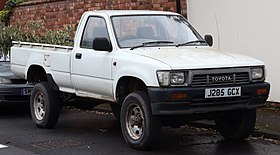 1991 Toyota Hilux 4×4 (pre-facelift) | |
| Overview | |
| Model code |
|
| Also called |
|
| Production | August 1988–1997 |
| Assembly |
|
| Designer | Shigeo Asai[27] |
| Body and chassis | |
| Body style |
|
| Layout | |
| Related | |
| Powertrain | |
| Engine | |
| Transmission |
|
| Dimensions | |
| Wheelbase |
|
| Length |
|
| Width | 1,689 mm (66.5 in) |
| Height |
|
The next redesign, in 1988, introduced a longer-wheelbase option, 3,099 mm (122 in) rather than 2,616 mm (103 in) for the regular wheelbase. Its one-piece cargo-box walls eliminated the rust-prone seams that were found in earlier models. The V6 Xtracab SR5 earned Motor Trend magazine's Truck of the Year award that year. The Xtra Cabs now featured more room behind the front seats than the last generation which allowed optional jump-seats for rear passengers, a feature more in line with competitors of the time.
In 1991, North American production began at the NUMMI plant in Fremont, California. The Hilux received a minor facelift in 1991 (for the 1992 model year), which was a grille change incorporating the new Toyota emblem that had been recently adopted.
It was during this generation that Toyota discontinued the Hilux line in North America (where it was marketed as the "Toyota Pickup"), replacing it with the new Tacoma for the 1995 model year.[28]
Engines
- 1988–1995: 1.8 L (1,812 cc) 2Y-U I4, 58 kW (79 PS; 78 hp) at 5,000rpm 140 N⋅m (100 lb⋅ft) at 3,200rpm
- 1988–1995: 1.8 L (1,812 cc) 2Y I4, 61 kW (83 PS; 82 hp) at 4,800rpm 140 N⋅m (100 lb⋅ft) at 2,800rpm (export markets)[29] Zdroj:https://en.wikipedia.org?pojem=Toyota_Hilux_(N80)
Text je dostupný za podmienok Creative Commons Attribution/Share-Alike License 3.0 Unported; prípadne za ďalších podmienok. Podrobnejšie informácie nájdete na stránke Podmienky použitia.
Antropológia
Aplikované vedy
Bibliometria
Dejiny vedy
Encyklopédie
Filozofia vedy
Forenzné vedy
Humanitné vedy
Knižničná veda
Kryogenika
Kryptológia
Kulturológia
Literárna veda
Medzidisciplinárne oblasti
Metódy kvantitatívnej analýzy
Metavedy
Metodika
Text je dostupný za podmienok Creative
Commons Attribution/Share-Alike License 3.0 Unported; prípadne za ďalších
podmienok.
Podrobnejšie informácie nájdete na stránke Podmienky
použitia.
www.astronomia.sk | www.biologia.sk | www.botanika.sk | www.dejiny.sk | www.economy.sk | www.elektrotechnika.sk | www.estetika.sk | www.farmakologia.sk | www.filozofia.sk | Fyzika | www.futurologia.sk | www.genetika.sk | www.chemia.sk | www.lingvistika.sk | www.politologia.sk | www.psychologia.sk | www.sexuologia.sk | www.sociologia.sk | www.veda.sk I www.zoologia.sk

